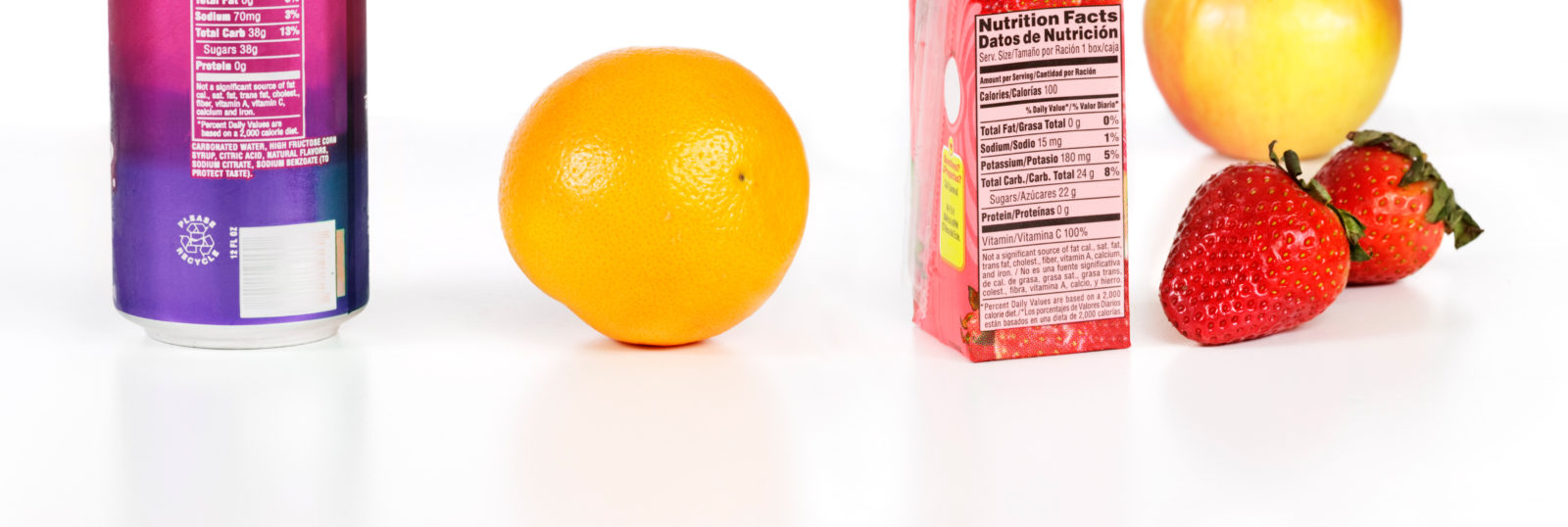Preschool years are a critical period for laying the foundation for a lifetime of healthy eating. Evidence shows that food preferences and eating habits developed at this age are strong predictors of what they’ll eat when they’re older. Carbohydrate and fat intake at ages 3 to 5 is strongly correlated to carbohydrate and fat intake at 7 to 8 years of age, when they begin making more food choices on their own.
Preschool years are also a critical period for obesity prevention. Children have an innate preference for sweet flavors (which, incidentally, is one of the reasons that breast milk is sweet). In theory, exposure to sweet food and drinks early in life can predispose children to a lifelong consumption of these foods. Children who consume soft drinks during infancy are likely to consume it in grade school.
In 2013, the beverage industry in the United States spent $140 million dollars to advertise 100% fruit juice and another $73 million to advertise “fruit drinks,” such as grape drink or fruit punch. A 2014 report found that 100 percent of fruit drink packages made nutrition-related and ingredient claims such as “100% DV [recommended daily value] of vitamin C,” “reduced sugar,” “good source of vitamin E,” and “one serving of fruit.” The packaging for 100 percent fruit juice and fruit drinks, especially if the brand offered both, tended to have similar look and names.
Though this information isn’t false, it is misleading. From such positive language, parents infer that the product is “healthy,” or at least a healthier option than carbonated beverages like Fanta. And although these drinks may be a “good source” of relatively readily available vitamins like C and E, they can be dangerous for a preschooler’s developing diet.
The American Academy of Pediatrics (APA) recommends serving preschoolers plain milk or water and avoiding drinks with added sugars. The APA also limits preschoolers’ consumption of 100 percent juice to four ounces daily, and recommends they avoid fruit drinks completely.
The Journal of the Academy of Nutrition and Dietetics recently published a study that looked at the overall nutrition for packed lunches, including the role of beverages, in preschool-aged children. The study examined 607 families in 30 early childcare and education centers. Fruit drinks comprised 25 percent of the lunches, 100 percent fruit juice comprised 14 percent, milk was another 14 percent, and flavored milk 3.7 percent of the lunches.
The fruit drinks had an average of 21 grams of sugar, 78 percent from added sugars. Flavored milk contained 26g of sugar, 50 percent from added sugars. One hundred percent juice included 20g of sugar with minimal added sugars (0.4%). All sugar in plain milk is naturally occurring.
The World Health Organization recommends reducing added sugars to 5 to 10 percent or less of total energy intake. Since children’s daily calorie needs are, on average, 1300, added sugar should be, at most, no more than 130 calories (32 grams or 8 teaspoons). If you’re aiming for 5 percent, added sugar can constitute only 65 calories a day (16 grams or 4 teaspoons)—the amount of added sugar in just one fruit drink box.
Traditional nutrition labels don’t make clear which sugars are naturally occurring—like those in plain milk—versus added sugars, since they’re all lumped together. Thankfully, the new nutrition label differentiates between naturally occurring sugars and added sugars, making it easier for consumers to make informed choices. Some companies have already begun to use the new label, and all companies are expected to be on board in the next two to three years.
***
If your kid is a juice junkie, don’t panic: there’s no need to go completely cold turkey. First, make healthy swaps where possible—flavored milk to plain, or fruit “drink” to 100% fruit juice—which can decrease your kid’s added sugar consumption by a third. Such a significant reduction can reduce your child’s risk for unhealthy weight gain and dental decay.
Secondly, if your preschooler turns their nose up at good ol’ fashioned H2O, try some optic tactics stolen from the food processing industry to make drinking water look more kid-friendly. You could try letting them decorate their very own kid-sized reusable bottle. Some kids are keener to drink water when it’s from a wacky straw. One veteran mom friend discovered that her water-averse toddler would positively chug water all day if it came from a (washed and rinsed) Mickey Mouse juice bottle she had bought on a whim.
However you choose to approach the challenge of reducing your child’s added sugar intake, be sure to engage your child in the process. Talk to them about the effects of sugar: “it can make your teeth brown and rotted!” The more children feel they have choices and control—even if it’s over something as seemingly silly as which sticker to put on their water bottle—the more invested they will feel in the choice. Enabling your child to feel empowered and informed will set a strong foundation for a lifetime of healthy eating habits.

